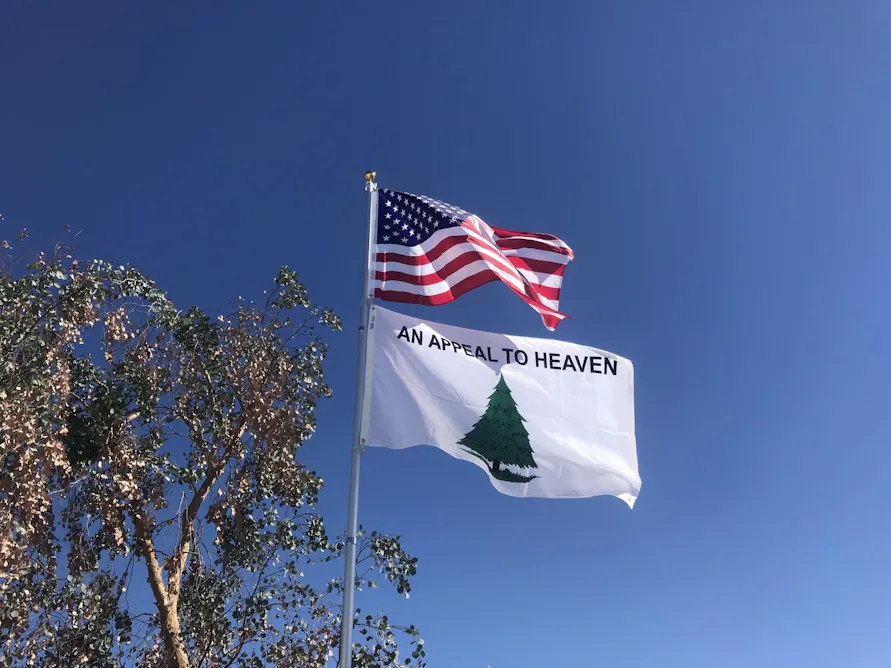The Appeal to Heaven Flag, originating in the American Revolution, is a symbol of significant historical and cultural relevance. Rooted in the colonial era, the flag features a pine tree and a bold statement, representing the colonists’ fight for self-governance.
This article delves into the flag’s origin, its role in revolutionary battles, and its enduring legacy in modern times.
Key Takeaways
- The Appeal to Heaven Flag originated during the American Revolution.
- Features a pine tree and a bold statement symbolizing the colonists’ fight for self-governance.
- Adopted by colonial forces in key revolutionary battles.
- Maintains cultural and political relevance in contemporary movements.
- Serves as a powerful reminder of the fight for independence and freedom.
- Historically significant and continues to inspire symbolism in modern times.

Origins of The Appeal To Heaven Flag
Historical Context
During the early 1770s, American colonists grew increasingly frustrated with British rule. Restrictions, taxes, and lack of representation in Parliament sparked the desire for independence.
In this turbulent period, the phrase “Appeal to Heaven” emerged from John Locke’s writings. It reflected the belief in a higher power’s justice over human laws. Massachusetts naval forces adopted this phrase, aligning with the widespread colonial sentiment of divine right to resist tyranny and seek self-governance.
This historical context set the stage for the creation of the Appeal to Heaven Flag.
Design and Symbolism
The Appeal to Heaven Flag is characterized by a green pine tree on a white field. The pine tree, an important symbol for New England colonists, represented resilience and natural rights.
It also had historical significance due to its use in the Pine Tree Riot against British naval restrictions on timber. The phrase “Appeal to Heaven” accompanied the pine tree, invoking divine support for their cause.
The flag’s design was straightforward yet powerful, combining regional symbolism with a rallying cry for justice and liberty. This unique blend of imagery and text embodied the colonists’ determination to seek freedom through both human and divine intervention.
It solidified its place as an emblem of resistance and independence.
Role in the American Revolution
Adoption by Colonial Forces
The Appeal to Heaven Flag was adopted by the Massachusetts Navy in 1775, initiated under the command of General George Washington.
The flag flew on six cruisers commissioned by Washington, symbolizing the colonies’ united resistance. This adoption wasn’t just a symbolic act; it represented the colonists’ collective commitment to challenging British rule.
The flag’s presence on naval vessels underscored its role as a motivator and moral booster for American forces. As a result, the flag became a rallying symbol for numerous militias, further cementing its importance in the revolutionary cause.
Significance in Key Battles
The Appeal to Heaven Flag played a crucial role in several key battles during the American Revolution.
Most notably, it was prominently displayed during naval engagements such as the Battle of Bunker Hill, which, despite being a British victory, bolstered the resolve of American forces.
The flag’s symbolism extended beyond naval confrontations; it also appeared in ground battles, providing a visual representation of unity and defiance against British oppression.
Its appearance in these significant encounters highlighted the colonists’ ideological resolve and their reliance on both divine justice and collective effort to achieve independence.
The flag, thus, became an enduring emblem of the American spirit and the quest for freedom.
Modern Usage and Legacy
Revival in Contemporary Movements
In recent years, the Appeal to Heaven Flag has experienced a resurgence in various contemporary movements. It has been adopted by groups advocating for issues such as individual liberties, government accountability, and constitutional rights.
The flag’s historical association with resistance against tyranny resonates with modern activists, making it a powerful symbol in protests and rallies. This renewed interest indicates the flag’s enduring relevance and its capacity to inspire new generations to uphold the principles of freedom and justice.
Cultural and Political Impact
The Appeal to Heaven Flag’s cultural and political impact extends beyond its historical roots. It has been embraced in various contexts, including public demonstrations and social media, serving as a visual representation of dissent and advocacy.
Politically, it has appeared in debates about states’ rights, federal overreach, and individual freedoms. Culturally, the flag has been featured in literature, art, and music, symbolizing a continued struggle for autonomy and justice.
This ongoing significance highlights the flag’s ability to adapt to new challenges while retaining its original spirit of resistance and appeal to higher principles. The flag remains a potent emblem in America’s collective consciousness, echoing the timeless quest for independence and self-governance.
Conclusion
The Appeal to Heaven Flag, with its roots in the American Revolution, continues to hold significant symbolic value.
Its adoption by colonial forces and role in key battles underscore its historical importance.
In modern times, the flag’s revival in various movements emphasizes its enduring relevance.
As both a cultural and political symbol, it persists as a powerful emblem of resistance, freedom, and the ongoing quest for justice and self-governance.
Frequently Asked Questions
When was the Appeal to Heaven Flag created?
The Appeal to Heaven Flag was created during the American Revolution, around 1775.
What does the pine tree on the flag symbolize?
The pine tree symbolizes resilience, natural rights, and historical significance related to the Pine Tree Riot against British restrictions.
Who adopted the Appeal to Heaven Flag initially?
The Massachusetts naval forces, under the command of General George Washington, first adopted the flag.
In what type of battles was the flag used?
The flag was used in both naval and ground battles, including the Battle of Bunker Hill.
Why is the flag still relevant today?
The flag remains relevant due to its historical significance and adoption by modern movements advocating for liberty and justice.
Has the flag appeared in contemporary culture?
Yes, it has been featured in literature, art, music, and political debates about freedoms and rights.
